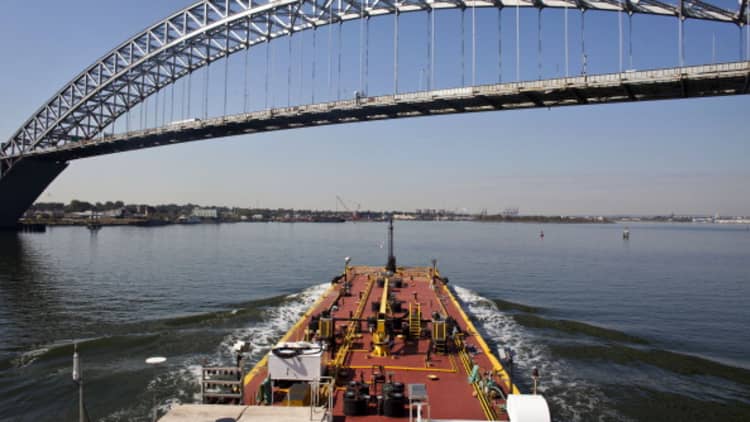
Amid fierce debate over the cost of the Trump administration's proposed infrastructure program, the White House has underscored its efforts to speed up regulatory reviews for projects — as a relatively low-cost element that businesses say helps them finance projects.
President Donald Trump has repeatedly hammered home his frustration with the permitting process, at press events often unrolling a lengthy scroll of paper showing a maze of more than a dozen federal agencies involved in building a new highway.
He again aired his frustrations with the system in a meeting with governors, mayors and local officials who assembled at the White House after the administration unveiled its infrastructure plan. "We can't give you money, and you're going to take 15 years to get a permit," Trump said.
The administration is calling for a single federal agency to take the lead on each project. It also would institute a firm deadline of two years to secure a permit — including 21 months for an environmental review, and three months after that for states to make a decision.
The current median length of time to complete an environmental impact study is 3½ years, according to 2016 data from the Department of Transportation. That represents a decline by nearly half since 2011, when the Obama administration put its first reforms into place.
The White House's inspiration for the two-year time frame comes from a report by regulatory reform advocacy group Common Good and its founder, Philip K. Howard. The white paper, titled "Two Years, Not Ten Years," suggests a politically accountable official with environmental experience should have sole discretion over the scope of a regulatory review.
The Common Good report uses the 64-foot raising of the Bayonne Bridge — an 87-year-old structure connecting northern New Jersey to New York's Staten Island — as a poster child for regulatory morass. The $1.6 billion "Raise the Roadway" project, first conceived in 2009 as a way to allow bigger ships and therefore more cargo into area ports, produced roughly 20,000 pages of environmental reviews.
The Bayonne Bridge elevation's completion in 2019 will come nearly a decade after it was conceived, and its development shows how complicated it can be to measure a project's regulatory cost. It qualified for "FAST track" permitting under a 2012 Department of Transportation program under the Obama administration. Once the Coast Guard was selected as the lead agency, the permitting process took just two years, despite the breadth of the documentation.
The first contact between the Coast Guard and the Port Authority of New York and New Jersey, the bridge's owners and managers, took place in March 2011. The permit was secured 26 months later, according to Chris Bisignano, bridge branch chief for the first Coast Guard district. Bisignano said further streamlining took place in 2014, when agencies agreed to work in tandem on regulatory reviews, not one at a time.
"In the old days, someone would look at a document, and then give it to the next person to look at — and now everyone is looking at it at the same time," Bisignano told CNBC. "We're sharing information, which saves time."
Environmental groups attempted to challenge the review, arguing nearby communities could face worsening traffic congestion and pollution-related health issues from the construction and increased commerce.
"They made it happen pretty fast, and they did it with total disregard for the community," said Amy Goldsmith, New Jersey director for environmental advocacy group Clean Water Action. A coalition of groups, including Clean Water Action, lost a legal challenge brought to mitigate environmental concerns.
Proponents of faster permitting believe the two interests are not mutually exclusive.
"We believe that you can do this without changing environmental law or changing the public input in the planning and approval of projects," said Ed Mortimer, executive director of transportation infrastructure at the U.S. Chamber of Commerce.
Still, others say a permit is useless if it's not followed by funding for the project at hand. The relatively small federal contribution in the Trump infrastructure plan, these critics say, is compounded by the administration's proposed steep budget cuts to government departments already tasked with improving infrastructure.
For the 2019 fiscal year, the White House has suggested a 20 percent cut to the budget for the Army Corps of Engineers, which builds and improves inland waterways
"The problem is there's no money. There are $90 billion of Army Corps of Engineers water projects ready to go with all the environmental reviews," said Scott Slesinger, legislative director at the Natural Resources Defense Council. "All the permits are there, and there's nothing to do."


